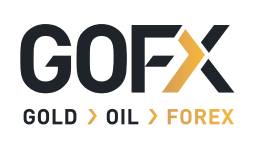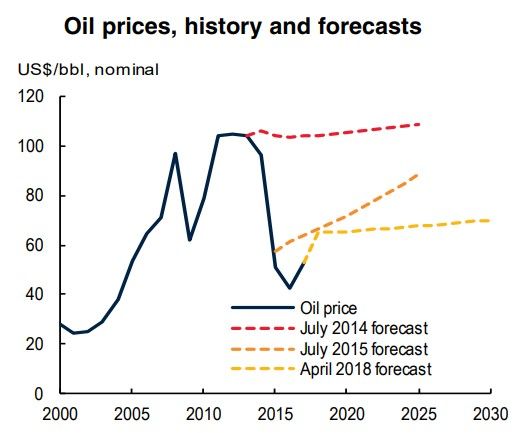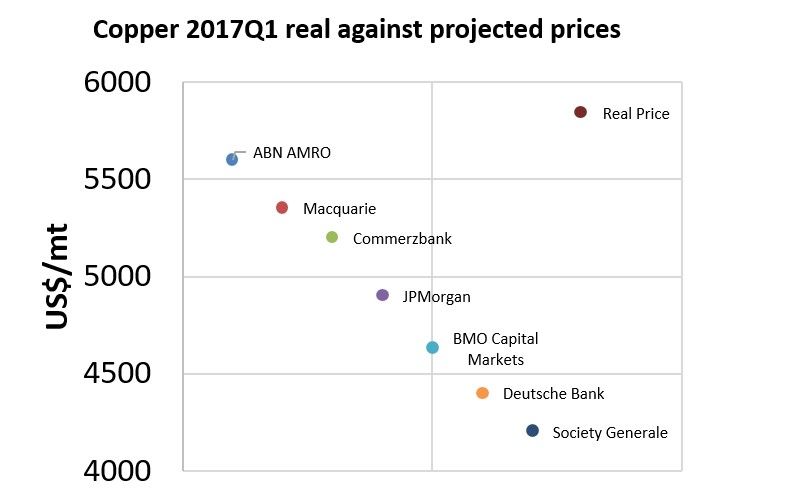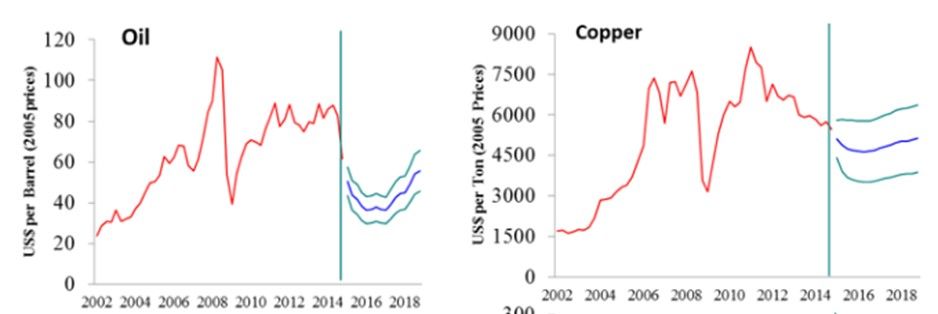BY LAMON RUTTEN
Understanding the basics of commodity price forecasts
Commodity price forecasts are widely used by businesses, governments and investors. In countries where one or a few commodities account for a large part of tax revenue (e.g., oil and mineral exporters), price forecasts often determine next year’s budget.
Commodity companies base projects on long-term price forecasts, and partly manage their cash flow on the basis of forecasts. Investors use price forecasts to determine if they should invest in a commodity or a company, or to the contrary, go short… With all this use of forecasting it is easy to forget that in fact, a forecast is little more than an educated guess.
Consider, for example, this chart showing World Bank crude oil price forecasts in three different years, and actual price developments:
Crude oil markets are huge, and studied intensely by a large number of organizations. Yet, when oil prices where high in 2014, not only the World Bank but most other organizations forecasted that they would remain high. As Edgar. R. Fiedler has remarked, the herd instinct among forecasters makes sheep look like independent thinkers.
Back in 2014, apparently no one reminded the oil price forecasters of an old adage of economics: the cure for high prices is high prices. Among other things, fracking become profitable, bringing huge new supplies to the world market. In the nine months after the July 2014 forecast was made, oil prices fell by half.
Of course, forecasters are likely to be right some of the time, and most of the time one can find a few forecasters who were right. But one cannot know who will be right this time… Consider the following chart:
This compares the copper price forecasted by different banks in mid-2016 with the actually realized price in the first quarter of 2017. One bank was reasonably right… But the range of forecasts was so large as to make it in practice impossible to base any firm decisions on them.
Of course, when using forecasts one has to recognize that forecasters do not mean their forecast to be one firm number. Rather, they estimate confidence intervals within which they expect prices to evolve. The “forecast” is merely the central point in this confidence interval. The follow charts shows that these confidence intervals are quite large:
If a forecaster in 2014 says the forecasted copper price in 2018 is 5,000 USD/ton, in fact he means that there is a likelihood of 5 out of 6 (or so) that the average copper price in 2018 will be between 4,000 and 6,000 USD/ton. With a still significant chance that it will actually be lower or higher…
The forecaster also does not predict how prices will arrive at their average levels – there could be large month-to-month fluctuations; and it will be of little relief for a company to find that the average price for the year was indeed as forecasted, but in the second month they ran out of cash because prices that month were particularly bad.
So, those using price forecasts should, at the very least, understand what is exactly forecasted. They have to plan for the uncertainty implicit in the forecast by, for example, managing the risk that prices will end up at the lower or higher part of the range, or that in any given shorter period prices may be quite different from their trend.
But given how wrong forecasts often prove to be (illustrated in the first chart above, which could be replicated for any other commodity), is it useful at all to use forecasts? Or are they just distractions?
Why bother with commodity price forecasts?
They will be useful if one understands how to use them. Forecasters uses previous data as inputs to make informed estimates that are used to predict the direction of future trends, using models of one form or the other. There are various types of commodity price forecasts which include; (5)
- judgmental forecasts based on quantitative and qualitative analysis of a variety of factors predicted to affect the price of the commodity in question;
- forecasts based on statistical models relying exclusively on historical price (these are particularly used in very short term forecasts, e.g., how will prices develop over the next hours or days);
- forecasts based on models that systematically incorporate all available information at the time of the forecast. There are different models used to calculate and forecast the prices of commodities, with the incorporation of futures prices in an error-correction framework yielding superior forecast performance.
Price forecasts can provide reasonable guidance about likely developments in prices over the longer term, at least in directional terms, on the basis of the currently available information. The process of forecasting enables the analyst to systematically reflect on all what may, in the future, affect price levels.
For example, what do we know about new mining capacity that is currently under development but will start adding to supply? How will expected economic growth in certain countries affect commodity demand? How will currency exchange rates influence commodity prices (as prices tend to be expressed in US dollars, a stronger US dollar normally means relatively lower commodity prices; and if the dollar weakens, commodity prices increase).
With this information, decision-makers can move from ignorance to risk – that is to say, measurable uncertainty. In a situation of ignorance, one cannot but wait and see what time brings. In a situation of risk, one can act proactively to manage it.
Furthermore, as the forecast incorporates all of the current information as well as known assumptions (e.g., on countries’ economic growth, exchange rates etc.), it becomes much easier and faster to understand how changes in conditions will influence the prices for one’s critical commodities. Furthermore, it is readily visible when there is a divergence between the price forecast and the actual price development, making it possible to react earlier and adjust plans.
In conclusion, no one should use price forecasts to make a decision (e.g., on a budget or an investment) and then just move ahead as if the forecast will become reality. Rather, use forecasts to guide you over time, and to help you properly manage your risks. Use a forecast well, and your resilience and adaptability will improve.
- The Fed Masih Pertahankan Suku Bunganya, Angkat Poundsterling Menguat
- Israel Isyaratkan Perluas Serangan, Minyak Terkoreksi Naik
- Harga Emas Meroket Didorong Konferensi Kebijakan Moneter The Fed
- Turunnya Harga Minyak Mentah Terseret Perundingan Gencatan Senjata Israel - Hamas
- Angka Penjualan Retail dan Indeks Manufaktur Tiongkok Menekan Pergerakan Aussie

